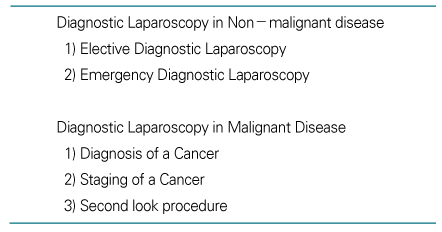 |
 |
- Search
| J Korean Med Assoc > Volume 46(8); 2003 > Article |
Abstract
The modern achievement of minimally invasive surgery has focused primarily on the treatment of benign diseases. Consequently, cholecystectomy, hernia repair, and fundoplication represent the overwhelming majority of laparoscopic procedures in western countries. Historically, however, the "keyhole" access to the abdominal cavity was intended to assess tumor spread or liver pathology. Creating a pneumoperitoneum has enabled surgeons to explore thoroughly specific areas of the abdomen such as the lesser sac, the subdiaphragmatic liver surface, or the lymph nodes at the celiac axis. In addition to using a laparoscopy for a diagnosis of benign diseases such as trauma and suspected appendicitis, as a logical consequence, operative diagnostic laparoscopy for purposes of staging malignancies related to the abdominal cavity has gained more and more attention.
References
1. Kelling G. Zur Colioskopie. Arch Klin Chir 1923;126:226-229.
2. Jacobeus HC. Kurze Ubersicht uber meine Erfahrungen mit der Laparoskopie. Munch Med Wschr 1911;58:2017-2019.
3. Cuesta MA, Nagy AG. Minimally invasive surgery in gastrointestinal cancer 1993;1st ed. Churchill Livingstone. 1-14. 33-50.
4. Hunter JG, Sackier JM. Minimally Invasive Surgery 1993;1st ed. McGraw-Hill. 3-6. 339-347.
5. Sackier J. Diagnostic laparoscopy in nonmalignant disease. Surg Clin North Am 1992;72:1033-1043.
6. Greene FL. Laparoscopy in malignant disease. Surg Clin North Am 1992;72:1125-1137.
7. Spinelli P, Felice GD. Laparoscopy in abdominal malignancies. Problems in General Surgery 1991;8:329-347.
- TOOLS
-
METRICS

-
- 0 Crossref
- Scopus
- 1,087 View
- 2 Download
-
Related articles in
J Korean Med Assoc -
Diagnostic Immunology1997 February;40(2)
Diagnostic Evaluation of Dyspnea1997 April;40(4)






